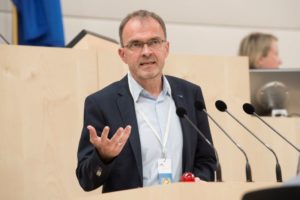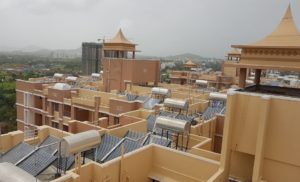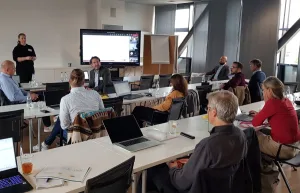Solar Thermal Energy in Antarctica
 Surviving in harsh climate: This vacuum tube collector system has heated the Brandfield House at the Rothera research station in the Antartic since February 2008.
Surviving in harsh climate: This vacuum tube collector system has heated the Brandfield House at the Rothera research station in the Antartic since February 2008.
Photo: British Antarctic Survey
It´s a harsh climate on the Adelaide Islands in the Antartic – 1,860 km south of the Falkland Islands. Heavy storms, temperatures far below zero and lots of snow in winter. Even so, the British Antarctic Survey (BAS) counts on solar technology. BAS used some PV off-grid systems for many years to supply instruments in remote areas. Last year, the research organisation installed three solar thermal systems in Rothera, Bird Island and Signy research stations to lower the carbon foot print of their research in the Antartic.
The largest of the solar thermal installations can be found at the Brandfield House for social activities in Rothera – installed in February of 2008. It consists of 36 vacuum tube collector panels, type ETC16, delivered by the British company Rayotec and manufactured by the German company Schott Solar. It stopped producing this type of panels last year due to technical problems. The other two stations are equipped with heat pipe vacuum tube collectors.
William Ray, sustainability engineer of BAS, estimates the solar thermal results at 500 kWh/m2. Still, the location for the installation had been a compromise. The collectors were installed at the ground floor façade of the Brandfield House, which is causing some problems with the shadows that the surrounding mountains cast. “Easy access for maintenance and prevention from heavy snow loads were the reason for this decision,” says Ray. “We have not completed our assessment of the panels yet, but so far they appear to be performing well.”
According to the BAS website “the performance of solar energy systems is far better than you might expect in such a harsh environment. Indeed, Rothera, for example, can receive more solar radiation over a year than anywhere in the UK”. Clean and dry air, extended summer daylight hours and higly reflective snow covering the ground are key reasons for this good performance. Also, an additional solar heating system will be installed on an accommodation building at Rothera research station in 2009. As part of the climate protection strategy, BAS will install more solar heating systems in the coming years.
More information:
http://www.bas.ac.uk/solar


